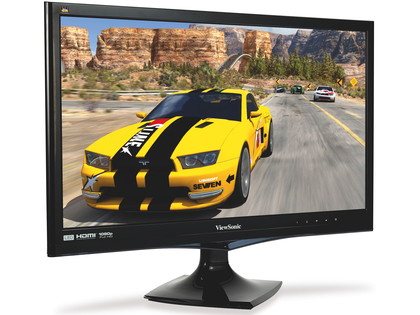Why you can trust TechRadar

While Nvidia is still, it must be said, struggling to produce an attractive 3D experience, screen manufacturers are at least finding more alluring ways to incorporate the tech into their products.
This ViewSonic screen's a good example.
As we've seen with a few laptops already, the IR emitter needed for stereoscopic 3D is built into the chassis. This cuts out the extra cables and desk clutter you get with the standalone IR emitter that comes with Nvidia's 3D Vision kit as standard.
The built-in emitter has another important advantage – because it's in a fixed position and never likely to be obscured or nudged by other peripherals, it makes for a more consistent 3D experience.
When you set the depth just right, images really pop out of the screen and you don't need to adjust it as often as you would a standalone emitter. With this panel more than any other, we found ourselves clawing at the screen like confused children, genuinely impressed by the depth and clarity of 3D images.
The chassis is attractive in its simplicity, although the controls are a bit unresponsive and the monitor's on/off light could be clearer. We approve most highly of the dual-link DVI, VGA and HDMI inputs too.
Screens do make some sacrifices for 3D functionality, though.
Because of the super-quick 120Hz refresh rate needed to produce 3D images, only twisted nematic (TN) panels can be used. They're the nippiest in terms of response time, but suffer from poor colour reproduction and limited viewing angle compared to a vertically aligned (VA) or in-plane switching (IPS) panel.
Here's the ace up ViewSonic's sleeve: considering the V3D245's built around a TN screen, the colour's remarkably good.
The blacks look inky and deep, the whites appear well-defined and true. The colour still loses a lot of ground to an IPS screen such as the Dell UD2412M or Asus' incredible PA238Q, while in-depth analysis reveals over-saturation of whites and working in a dark room shows how shallow the black scale really is.
Even so, it's one of the best TN screens we've pored over.
That makes for an attractive package, and a reasonable financial outlay too. For £360, this ViewSonic screen offers a hassle-free 3D setup with glasses included, and a good quality screen for good old-fashioned 2D viewing too.
If you're searching first and foremost for a screen with exceptional colour, Dell's slightly cheaper UD2412 or Asus' PA238Q are unbeatable, but if you're hell-bent on going cross-eyed and turning your favourite games into pop-up picture books, the V3D245 is a great way to do it.
We liked
It's a genuinely impressive example of a 3D panel, and the inbuilt receiver makes the 3D Vision experience a far less cluttered one.
There's also the fact that as a 120Hz panel it's pretty darned good as a standard 2D screen too, and despite being limited to the TN display technology it's one of the best we've seen.
We disliked
There's not a huge amount to dislike; if you want a 3D monitor this ViewSonic is one of the top we've tested. That said if you're not sure about this 3D malarkey the cheaper Dell UD2412 and Asus PA238Q make for better panels.
Verdict
Takes the hassle away from setting up 3D, and chucks in a good-quality screen to sweeten the deal.

Ad creative by day, wandering mystic of 90s gaming folklore by moonlight, freelance contributor Phil started writing about games during the late Byzantine Empire era. Since then he’s picked up bylines for The Guardian, Rolling Stone, IGN, USA Today, Eurogamer, PC Gamer, VG247, Edge, Gazetta Dello Sport, Computerbild, Rock Paper Shotgun, Official PlayStation Magazine, Official Xbox Magaine, CVG, Games Master, TrustedReviews, Green Man Gaming, and a few others but he doesn’t want to bore you with too many. Won a GMA once.